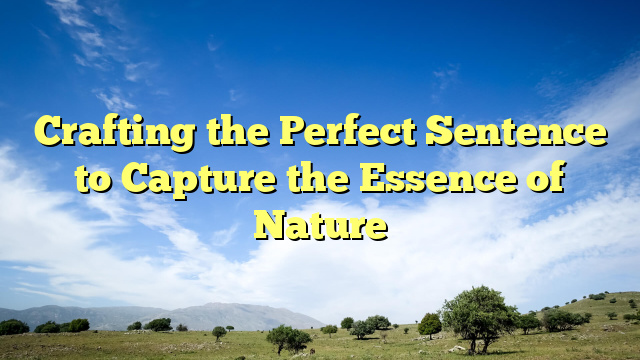Crafting the Perfect Sentence to Capture the Essence of Nature
Crafting the Perfect Sentence to Capture the Essence of Nature
Writing about nature involves more than just describing the environment around us. It’s about capturing the essence, the very soul of nature in our words. Crafting the perfect sentence to encapsulate the beauty, the mystery, and the awe of nature is an art form. In this article, we will explore techniques, styles, and examples to help you write sentences that breathe life into the natural world.
Understanding the Elements of Nature Writing
Nature writing is not just about observation; it’s about connection. To write effectively about nature, one must first understand its elements and how they interact with our senses and emotions.
Observation and Detail
Start with keen observation. Pay attention to the details – the color of the sky, the texture of a leaf, the sound of a river. These details are the building blocks of your sentence.
Emotion and Reflection
Nature evokes emotion. Reflect on how a scene makes you feel. Is it awe, peace, or perhaps a sense of mystery? Your sentence should aim to evoke similar emotions in your reader.
Imagery and Metaphor
Use imagery and metaphor to draw parallels between nature and human experience. This not only makes your writing more relatable but also deepens the reader’s connection to the natural world.
Techniques for Crafting Your Sentence
With an understanding of what makes nature writing compelling, let’s explore specific techniques to craft your perfect sentence.
Be Precise with Your Words
Choose words that are precise and evocative. Instead of saying “the bird flew,” say “the sparrow darted through the emerald canopy.”
Vary Your Sentence Structure
Varying sentence structure can mimic the unpredictability and rhythm of nature. Combine short, impactful sentences with longer, more descriptive ones to keep your writing dynamic.
Invoke the Senses
Don’t just focus on what you see. Describe what you hear, smell, touch, and even taste. This sensory approach brings your reader closer to the experience.
Examples of Nature Sentences
Let’s look at some examples of sentences that effectively capture the essence of nature:
- “The morning dew clung to the spider’s web, each droplet a tiny prism reflecting the dawn’s first light.”
- “A chorus of cicadas sang through the heat of the summer night, their song both a lullaby and a celebration.”
- “Beneath the ancient oak, its bark gnarled with stories of old, I found solace in its steadfast presence.”
Practice Exercises
To hone your skills, here are some exercises:
- Choose a natural object and describe it using all five senses.
- Write a sentence that captures a moment in nature, then rewrite it three times, each time focusing on a different emotion.
- Find a nature photograph and write a sentence that not only describes it but also tells a story.
Conclusion
Crafting the perfect sentence to capture the essence of nature is a blend of observation, emotion, and artful use of language. By focusing on the details, invoking the senses, and practicing your craft, you can write sentences that bring the natural world to life for your readers. Remember, the goal is not just to describe nature but to connect your reader to it in a deep and meaningful way.
Further Reading and Resources
For those interested in exploring nature writing further, here are some resources:
| Book | Author |
|---|---|
| “Pilgrim at Tinker Creek” | Annie Dillard |
| “A Sand County Almanac” | Aldo Leopold |
| “The Overstory” | Richard Powers |
By studying the works of these authors, you can gain insights into the craft of writing about nature and find inspiration for your own sentences. Remember, the perfect sentence is not just about what is said, but how it makes the reader feel and the connection it fosters with the natural world.

